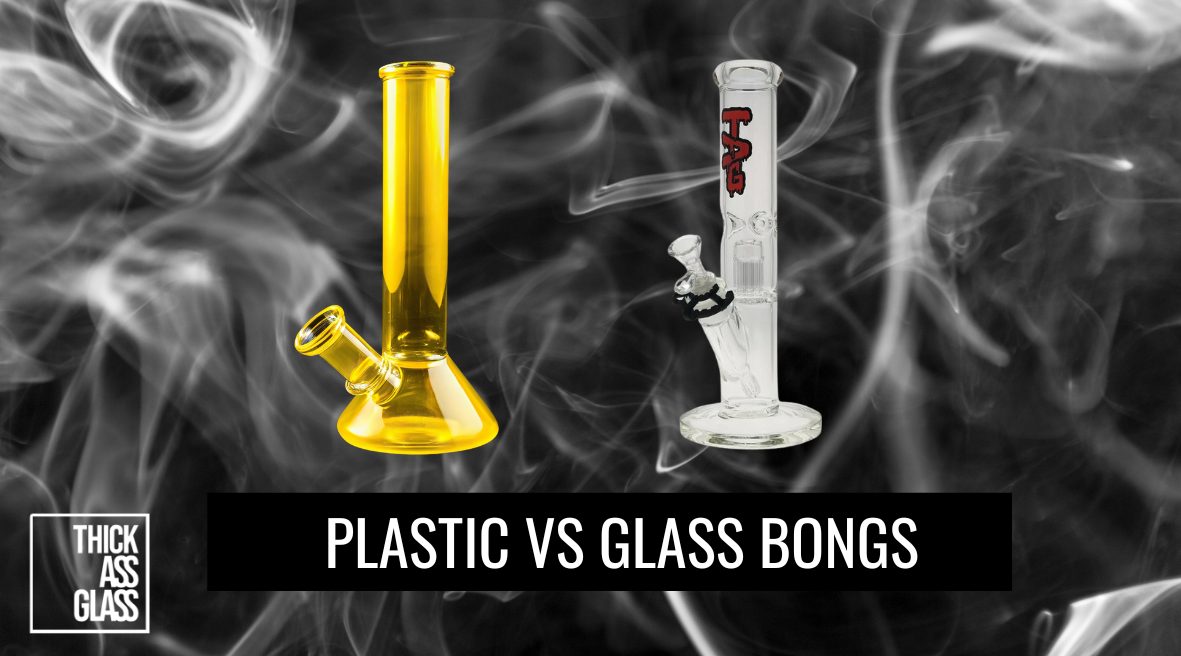Glass, just glass. Glass is the answer.
In our minds, there isn’t much debate. Glass is easier to clean, gives you cleaner hits, and has precision airflow.
That’s not to say plastic bongs don’t have a place. In case you need something cheap, lightweight, and nearly indestructible, acrylic bongs have their advantages.
This guide breaks it all down—durability, maintenance, price, smoking experience, and even health considerations—so you can make an informed choice.
Whether you're a seasoned smoker or a first-time buyer, we’re cutting through the noise and giving you the facts.
The Evolution of Bong Materials: From Ancient Clay to High-Tech Glass
Bongs have been around for centuries, long before today’s scientific glass designs and acrylic water pipes. The materials have changed, but the goal has always been the same—smoother, cooler hits with better filtration. If you’ve ever wondered how we got from bamboo and clay pipes to today’s borosilicate glass bongs, here’s the full breakdown.
The Rise of Glass Bongs: A Game Changer
Glass changed everything.
While ceramic and metal bongs were still common throughout the 20th century, the late 1970s and 1980s saw the rise of hand-blown glass pipes. At first, these were simple straight tubes or beaker bongs, but it didn’t take long for glass artists to push the limits.
By the 1990s, pioneers like Bob Snodgrass had revolutionized the industry with borosilicate glass bongs that were stronger, cleaner, and more customizable. This was when percolators, ice catchers, and diffused downstems became the norm. Suddenly, smoking wasn’t just about getting the job done—it was about getting the smoothest, most flavorful hit possible.
Plastic and Silicone: Cheap and Durable, But At What Cost?
Around the same time, plastic bongs (acrylic water pipes) started appearing in gas stations and head shops. These were cheaper, harder to break, and lightweight, making them a go-to for casual users and travelers. But acrylic and plastic bongs come with compromises:
-
They retain odors and stains over time.
-
They can warp with heat, affecting airflow and seal quality.
-
The taste is never as clean as with glass water pipes.
Silicone bongs later emerged as an alternative—indestructible, flexible, and heat-resistant—but they still can’t match glass in filtration, airflow, or aesthetics.
Smoking from Glass vs. Plastic— How It Really Feels
At the end of the day, the most important question isn’t which bong is cheaper or more durable—it’s which one delivers the best smoking experience. If you’ve ever compared a glass water pipe to an acrylic bong, you already know the difference.
But if you haven’t, let me break it down.
Smoothness: Glass Wins Every Time
Smoking is all about airflow and filtration.
When you take a hit, you want a cool, smooth pull that doesn’t feel harsh on your throat. Glass bongs excel here for a few key reasons:
-
Borosilicate glass is non-porous, meaning it doesn’t trap odors, flavors, or bacteria. Every hit is as clean as the first.
-
Glass bongs support advanced percolation systems—honeycomb percs, tree percs, and matrix percs—that cool and filter the smoke far better than a basic plastic downstem.
-
Airtight seals in glass bongs ensure smooth, consistent airflow, unlike plastic bongs, which can develop small leaks over time.
Acrylic bongs, on the other hand, offer little to no percolation, meaning you’re basically inhaling hot, unfiltered smoke. You might not notice the difference if you’re new to bongs, but once you’ve taken a rip from a diffused downstem or a multi-perc glass bong, there’s no going back.
Taste: Contamination Destroys Flavor
Ever drink water from a plastic bottle that’s been sitting in the sun?
That’s the same effect you get with plastic bongs over time. Acrylic is porous and absorbs flavors, meaning every session leaves behind a little residue that alters the taste of your next hit.
Glass, on the other hand, preserves the pure flavor of your herb. This is especially important if you’re smoking high-quality flower with rich terpene profiles—the last thing you want is plastic interfering with the taste.
Heat Resistance: No Contest
Plastic and heat don’t mix well.
Even if an acrylic water pipe doesn’t visibly melt, high temperatures can release fumes from the plastic, which is something you definitely don’t want in your lungs. Borosilicate glass bongs are built to withstand extreme heat without any risk of warping or chemical contamination.
The Winner: Glass By a Mile
If you’re after smooth airflow, clean flavor, and superior cooling, glass is the clear winner.
Acrylic bongs are fine for budget-conscious buyers, but when it comes to the smoking experience, nothing beats the precision, function, and purity of a well-made glass bong.
Glass vs. Plastic—What’s Less Harmful to Your Lungs?

If you’re inhaling smoke through a bong, the last thing you want is random chemicals making their way into your lungs. This is where glass bongs and acrylic bongs aren’t even in the same league.
Glass is Pure. Plastic? Not So Much.
High-quality borosilicate glass is completely non-toxic, heat-resistant, and non-porous. It won’t release chemicals, absorb odors, or degrade over time. What you load into the bowl is what you taste—nothing more, nothing less.
Plastic, on the other hand?
That’s where things get sketchy.
Most acrylic water pipes use lower-grade plastics that can leach chemicals when exposed to heat. Even if you’re not directly torching the plastic, the warmth from repeated use can degrade the material over time, releasing microplastics or fumes you definitely don’t want to inhale.
Bacteria, Mold, and Residue Build-Up
Plastic bongs are harder to clean and tend to develop scratches that trap bacteria and resin. No matter how much you rinse them, there’s always a lingering taste—and possibly some hidden contaminants. Glass bongs? A quick soak in isopropyl alcohol and salt restores them to a pristine, like-new state.
Long-Term Health Risks
There’s a reason food-grade and medical-grade materials avoid certain plastics. Continuous exposure to BPA, phthalates, and other chemicals found in some acrylics isn’t something to ignore. If you’re using a plastic bong daily, you could be exposing yourself to unseen risks that simply don’t exist with glass.
Durability and Longevity: Which Bong Holds Up Over Time?
When it comes to durability, there’s no denying that acrylic bongs have the advantage in one area—they don’t break. You can drop a plastic bong off a table, toss it in a backpack, or knock it over, and it’ll survive. But does that mean it’ll last? Not really.
Plastic Bongs: Durable But Disposable
Acrylic bongs might be impact-resistant, but they don’t age well. Over time, scratches, discoloration, and warping take their toll. Cheap plastic absorbs resin, stains easily, and holds onto odors, making it impossible to fully clean. After a few months of regular use, most plastic bongs start to look (and smell) pretty rough.
And let’s talk about structural integrity—the rubber grommets and plastic downstems used in acrylic bongs degrade over time, leading to air leaks and weak seals. You might not break a plastic bong, but eventually, it’ll stop functioning as well as it did on day one.
Glass Bongs: Fragile? Not If You Buy Quality.
The biggest argument against glass is that it’s breakable.
But here’s the thing—not all glass is created equal. A cheap, thin-walled import? Sure, that’ll break easily. But a high-quality borosilicate glass bong—especially one with 9mm walls and a 16mm beaker base like we make at TAG—can take a beating.
Plus, glass doesn’t degrade like plastic. With proper care, a borosilicate glass bong will last for years, retain its clarity, and function just as smoothly as the day you bought it.
Portability and Practicality: Which Bong Fits Your Lifestyle?
Not everyone needs a heavy-duty, stay-at-home glass bong.
If you’re always on the move, portability matters, and that’s where plastic bongs have a legitimate edge.
Plastic Bongs: Lightweight and Travel-Friendly
Acrylic bongs are practically indestructible and weigh next to nothing. You can throw one in a backpack, take it camping, or pass it around at a party without stressing about it shattering. If you’re someone who travels a lot or needs a cheap, no-worries option, plastic gets the job done.
Unfortunately, convenience comes with trade-offs.
Plastic bongs get dirty fast, retain smells, and degrade over time. That portable acrylic piece might survive being dropped, but after a few months, it’ll be scratched, cloudy, and impossible to fully clean.
Glass Bongs: Not as Fragile as You Think
People assume glass bongs aren’t portable, but that depends on thickness and design. A TAG mini beaker with 9mm walls is way more durable than most people realize. As an added bonus, compact glass designs still give you superior airflow, filtration, and clean flavor—things you just don’t get with plastic.
And if you’re worried about breakage? Protective bong cases and silicone sleeves exist for a reason. Treat your glass right, and you can absolutely take it on the go.
Making Your Decision: What’s the Best Bong for You?
So, glass vs. plastic bongs—which one should you choose?
The answer comes down to what you value most. Are you looking for the smoothest, cleanest hits? Or do you just need something cheap and unbreakable?
Cost vs. Long-Term Value
If you’re making your decision based purely on price, plastic bongs win—at least upfront. You can grab a basic acrylic water pipe for $10 to $30, while a quality borosilicate glass bong starts around $50 and can go into the hundreds depending on thickness, percolation, and craftsmanship.
But here’s the thing—glass bongs last.
A well-made borosilicate piece can be your daily driver for years, while a plastic bong scratches, stains, and needs replacing every few months. Over time, you’ll spend more replacing cheap acrylic bongs than you would investing in one solid glass piece.
Functionality: Smoothness and Flavor Matter
If you actually care about airflow, filtration, and taste, the choice is clear—glass bongs deliver a superior smoking experience.
-
Glass preserves the pure flavor of your herb, while plastic absorbs smells and flavors.
-
Percolators, diffused downstems, and ice catchers make glass bongs smoother and cooler to hit.
-
Glass maintains airtight seals, while plastic bongs warp and leak over time.
For daily smokers and connoisseurs, the clean, smooth draw of glass makes it worth the extra cost.
My Take: Glass is the Better Investment

If you just need something cheap to get the job done, plastic works. But if you want cleaner hits, better airflow, and a bong that won’t need replacing every few months, glass is the clear winner. Spend a little more now, and you’ll get better performance and long-term value—plus a piece you can actually be proud to own.
What to Look For When Shopping for Bongs Online
Online shopping offers the widest selection, competitive prices, and direct access to premium brands—but not all sites can be trusted. Here’s what to look for:
✔ Thick Borosilicate Glass – If you’re buying a glass bong, it should be made from borosilicate glass, ideally 5mm thick or more for durability. Avoid anything just labeled "glass" without details.
✔ Detailed Product Descriptions – A legit seller provides precise specs (glass thickness, percolators, joint size) rather than vague marketing fluff.
✔ Verified Customer Reviews – Look for detailed reviews and real user feedback. Be wary of sites with only perfect ratings or generic comments.
✔ Fair Pricing (Not Too Cheap!) – If a "high-quality bong" is selling for $20, it’s not high quality. Good glass isn’t dirt cheap, so if a price seems too good to be true, it probably is.
Get Your Perfect Bong Today
If you care about smooth hits and clean flavor, glass is the only real choice.
A quality borosilicate glass bong is an investment in a better smoking experience. With superior airflow, better filtration, and long-lasting performance, glass bongs deliver cleaner, cooler, and more satisfying rips every time.
If you’re ready to upgrade, don’t settle for thin glass or mass-produced imports. At Thick Ass Glass (TAG), we design our pieces with durability and function in mind—thick walls, reinforced joints, and precision-engineered airflow for the smoothest possible pull.
👉 Shop now at ThickAssGlass.com and find a piece built to last.


